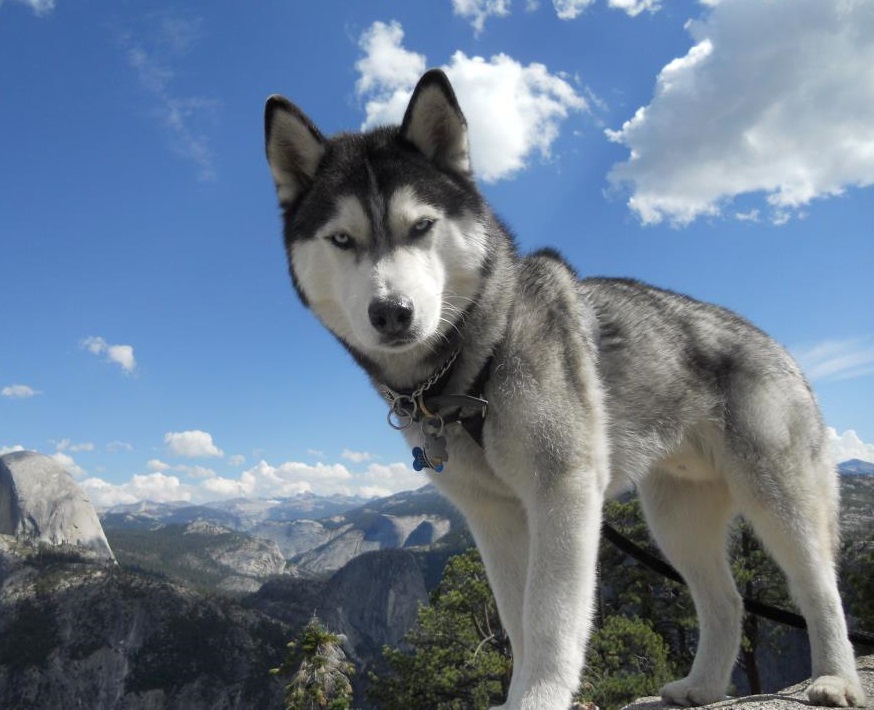
Siberian Husky

Navigate through the tabs
Navigate through the tabs below to view the breed's info of your interest.
The breed's info is divided in four sections; namely:
the breed's history ,
the breed's main stats ,
the dog's potential health issues
and finally, how the breed scored in 26 different categories.
All the above information should give you a respectively good overview for the dog of your interest.
Dog Breed's Main Info
The Breed's History:
The Siberian Husky, Samoyed, and Alaskan Malamute are all breeds directly descended from the original sled dog. It is thought that the term "husky" is a corruption of the nickname "Esky" once applied to the Eskimo and subsequently to their dogs.
Breeds descending from the Eskimo dog or Qimmiq were once found throughout the Northern Hemisphere from Siberia to Canada, Alaska, Greenland, Labrador, and Baffin Island.
With the help of Siberian Huskies, entire tribes of people were able not only to survive, but to push forth into terra incognita. Admiral Robert Peary of the United States Navy was aided by this breed during his expeditions in search of the North Pole.
Dogs from the Anadyr River and surrounding regions were imported into Alaska from 1908 (and for the next two decades) during the gold rush for use as sled dogs, especially in the "All-Alaska Sweepstakes," a 408-mile (657-km) distance dog sled race from Nome, to Candle, and back.
Smaller, faster and more enduring than the 100- to 120-pound (45- to 54-kg) freighting dogs then in general use, they immediately dominated the Nome Sweepstakes. Leonhard Seppala, the foremost breeder of Siberian Huskies of the time, participated in competitions from 1909 to the mid-1920s.
On February 3, 1925, Gunnar Kaasen was first in the 1925 serum run to Nome to deliver diphtheria serum from Nenana, over 600 miles to Nome. This was a group effort by several sled-dog teams and mushers, with the longest (91 miles or 146 km) and most dangerous segment of the run covered by Leonhard Seppala.
The Iditarod Trail Sled Dog Race commemorates this famous delivery. The event is also loosely depicted in the 1995 animated film Balto, as the name of Gunnar Kaasen's lead dog in his sled team was Balto, although unlike the real dog, Balto the character was portrayed as half wolf in the film. In honor of this lead dog, a bronze statue was erected at Central Park in New York City.
In 1930, exportation of the dogs from Siberia was halted. The same year saw recognition of the Siberian Husky by the American Kennel Club. Nine years later, the breed was first registered in Canada. The United Kennel Club recognized the breed in 1938 as the "Arctic Husky," changing the name to Siberian Husky in 1991.
Seppala owned a kennel in Nenana before moving to New England, where he became partners with Elizabeth Ricker. The two co-owned the Poland Springs kennel and began to race and exhibit their dogs all over the Northeast.
As the breed was beginning to come to prominence, in 1933 Navy Rear Admiral Richard E. Byrd brought about 50 Siberian Huskies with him on an expedition in which he hoped to journey around the 16,000-mile coast of Antarctica. Many of the dogs were trained at Chinook Kennels in New Hampshire.
Called Operation Highjump, the historic trek proved the worth of the Siberian Husky due to its compact size and greater speeds. Siberian Huskies also served in the United States Army's Arctic Search and Rescue Unit of the Air Transport Command during World War II. Their popularity was sustained into the 21st century.
They were ranked 16th among American Kennel Club registrants in 2012, rising to 14th place in 2013.
The original sled dogs bred and kept by the Chukchi were thought to have gone extinct, but Benedict Allen, writing for Geographical magazine in 2006 after visiting the region, reported their survival. His description of the breeding practiced by the Chukchi mentions selection for obedience, endurance, amiable disposition, and sizing that enabled families to support them without undue difficulty.
Country of Origin:
Siberia / Russia
Breed Group:
Working
Height:
1 foot, 8 inch. to 1 foot, 11 inch. (50,8 to 58,42 cm)
Weight:
35 pounds to 60 pounds (15,87 to 27,22 Kg)
Life Span:
12 to 15 years
Potential Health Issues:
Cataracts,
Corneal Dystrophy,
Progressive Retinal Atrophy (PRA)
Adaptability
Apartment Living:
First Time Owners:
Sensitivity:
Being Alone:
Cold Weather:
Hot Weather:
Friendliness
Affection With Family:
With Kids:
With Dogs:
With Strangers:
Health and Grooming
Shedding:
Drooling:
Easy To Groom:
Overall Health:
Weight Gain Potential:
Size:
Training
Easiness:
Intelligence:
Mouthiness:
Prey Drive:
Barking or Howling:
Wanderlust:
Need For Exercise
Energy Level:
Intensity:
Exercise Needs:
Playfulness:
Our Mobile Application
Check out Our Mobile Application "Dog Breeds Central"
